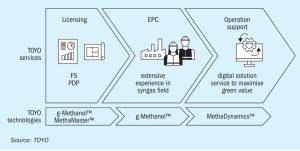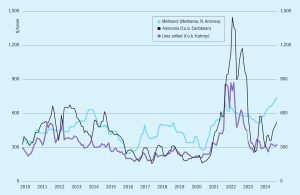
Market Outlook
Prices in most markets should register declines through January, though the extent to which benchmarks will ease is yet unclear. Chinese suppliers have seen significant price declines in recent weeks.

Prices in most markets should register declines through January, though the extent to which benchmarks will ease is yet unclear. Chinese suppliers have seen significant price declines in recent weeks.

Carbon Recycling International (CRI), which operates a geothermally powered green methanol plant at Svartsengi, 40km southwest of Reykjavik, had to evacuate its site in late November when a 3km fissure opened in the earth a few kilometres away and lava began spilling across adjacent land. Satellite photos of the area taken on November 24 show a large field of molten and cooled lava to the north, west, and south of Svartsengi, though the plant itself remained undamaged. CRI’s Iceland facility runs on CO2 , water, and renewable electricity from the Svartsengi geothermal power station. CRI says the low-carbon energy source allows it to produce 4,000 t/a of methanol with a greenhouse gas footprint just 10–20% that of conventional methanol.

A complete list of all articles and news items appearing in Nitrogen+Syngas magazine during 2024.

While there is still a considerable push for use of biomass waste as a lower carbon feedstock for chemical production via gasification to syngas, biological processes such as fermentation are increasingly gaining traction as an alternative.

Toyo Engineering Corporation has developed two new digital solutions, MethaMaster™ and MethaDynamics™ , which enhance the operational efficiency of e-methanol production from variable renewable energy.
Johnson Matthey technology selected for one of the largest planned e-methanol plants in Europe Reolum project represents the fifth win contributing to JM’s strategic milestone of 20 sustainable technologies project wins by the end of 2025/26 JM has won 15 major energy transition projects since 1st April 2022 Sustainable energy project to operate in region […]

Ammonia prices could remain stable for the duration of October, with any further increases likely to be capped by a lack of demand. The outlook for November is more positive for buyers, with prices set to ease off once turnarounds at key export hubs are concluded.
Sachin Nijhawan has been appointed as the new CEO of thyssenkrupp nucera US, and Juergen Grasinger was named Chief Operating Officer to advance the company’s international growth strategy and expand its global leadership in the manufacturing and supply of hydrogen production technology. Based out of the thyssenkrupp’s Houston office, Nijhawan will be responsible for the business activities of the US operations.

Methanex Corporation has entered into a definitive agreement to acquire OCI Global’s international methanol business for $2.05 billion. The transaction includes OCI’s interest in two world-scale methanol facilities in Beaumont, Texas, one of which also produces ammonia. The transaction also includes a low-carbon methanol production and marketing business and a currently idled methanol facility in the Netherlands.

Dr Burkhard Lohr , the chair of the executive board of K+S Aktiengesellschaft, will retire at the end of May next year, after more than 12 years in the role, having decided not to extend his current mandate.